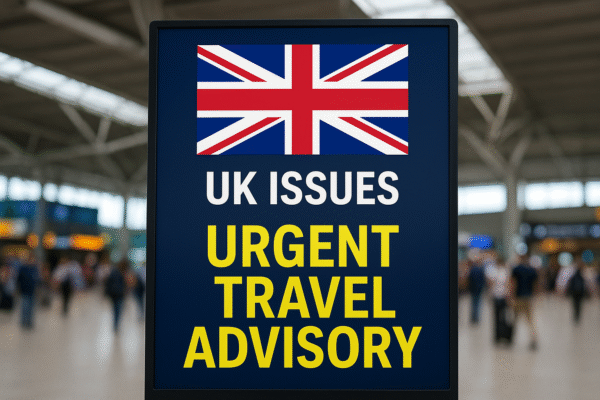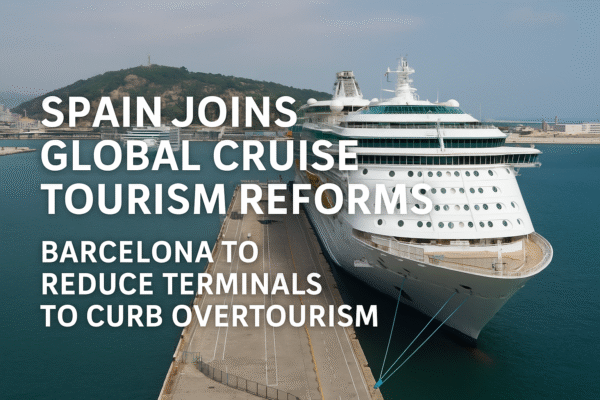In a major step toward sustainable tourism, Spain has officially joined Italy, the United States, France, Croatia, and the Netherlands in implementing strict cruise ship reforms to combat overtourism. Barcelona, one of Europe’s busiest cruise ports, is set to cut two of its current seven terminals in a bold five-year strategy that will reduce cruise capacity while modernizing remaining infrastructure to prioritize sustainability and public use.
The move reflects a growing international consensus among coastal cities: cruise tourism, while economically beneficial, must be managed to preserve historic centers, protect environmental resources, and safeguard the quality of life for residents.
Barcelona Cruise Terminal Cuts: A Strategic Shift
Barcelona’s Port Authority will eliminate Terminals A, B, and C at the Adossat Wharf by 2028, reducing the number of terminals from seven to five. In their place, a newly built, publicly owned Terminal C will emerge, capable of processing up to 7,000 cruise passengers at a time. Designed with shore power compatibility, the terminal will allow ships to shut down their engines while docked—significantly reducing emissions and noise pollution in the area.
This cruise reform will also include a €50 million overhaul of the adjacent quay and passenger areas and a €90 million pedestrian-and-cycle-friendly Porta d’Europa bridge connecting the port directly to the city by 2027. These developments are part of a long-term commitment to reduce congestion and decentralize tourism in Catalonia’s capital.
Even as Barcelona’s cruise traffic rose 20% between 2018 and 2024, city leaders have chosen to prioritize sustainability. The city is also rolling out smart signage and real-time tourist flow information at key landmarks like La Sagrada Familia and Las Ramblas to encourage more even distribution of visitors across neighborhoods.
Venice: Preserving a Lagoon in Peril
Italy’s Venice was one of the first European cities to enact cruise restrictions when it banned large ships from the Giudecca Canal and St. Mark’s Basin in 2021. Ships now dock at Marghera, preserving the fragile lagoon and reducing wave damage to historic infrastructure.
Rome reinforced Venice’s policy with a national law amendment to limit high-impact tourism. While smaller vessels remain allowed, Italy’s shift has been celebrated globally as a model for balancing tourism with cultural preservation.
United States: Local Activism Drives Change
In the U.S., cities like Key West, Florida; Bar Harbor, Maine; and Juneau, Alaska are leading grassroots movements to cap cruise tourism. Key West attempted to restrict ships with over 1,300 passengers, though state laws partially blocked the initiative. Bar Harbor successfully capped daily cruise arrivals to 1,000, while Juneau’s new agreement with major cruise lines will limit visitors to 16,000 per day on weekdays and 12,000 on Saturdays starting in 2026.
Monterey, California went further—halting all cruise ship disembarkation indefinitely. These actions represent a dramatic rethinking of how cruise tourism is managed in small and mid-sized port towns.
Dubrovnik: Protecting a World Heritage Gem
Dubrovnik, Croatia, once overwhelmed by over 1.1 million cruise tourists annually, now allows only two ships to dock per day. The measure has helped regulate visitor flow in the UNESCO-listed Old Town and ease pressure on local infrastructure. The city’s improved scheduling coordination with cruise lines has also helped distribute foot traffic more evenly throughout the week.
France: Regulating with Refinement
France is also tightening cruise restrictions in Cannes and Nice. Starting January 2026, Cannes will permit only one large ship per day, capping total cruise visitor numbers at 6,000. Nice will enact even stricter rules in July 2025, banning ships with over 900 passengers from docking entirely. These rules aim to protect the Riviera’s character and manage tourism density.
Amsterdam: Long-Term Vision for Cruise Decline
The Netherlands’ capital is taking a long-term approach. By 2026, the number of annual cruise calls in Amsterdam will be capped at 100—almost half of today’s volume. Shore power will become mandatory by 2027, and ships will be banned from docking in the historic city center by 2035. Instead, Amsterdam will relocate cruise operations to peripheral zones, aligning with the city’s broader sustainability goals and livability strategy.
A Global Shift Toward Cruise Accountability
These coordinated reforms across Europe and North America represent a growing consensus that unregulated cruise tourism is no longer viable. Once viewed as a boost to local economies, cruise traffic is now increasingly seen as a burden on infrastructure, air quality, and urban integrity.
According to a 2024 report by the European Commission, cities receiving high cruise volumes experience significantly more pollution and wear on public services than other forms of tourism. Furthermore, data from Cruise Lines International Association (CLIA) reveals that global cruise passenger numbers are expected to surpass 35 million by 2026, placing further strain on urban ports.
In response, cities like Barcelona are crafting long-term urban planning strategies focused on quality over quantity. By combining port downsizing with smart technologies, public ownership, and climate-conscious development, these reforms demonstrate how ports can thrive while preserving the cultural and environmental heritage that draws visitors in the first place.
The Road Ahead: A Model for Sustainable Cruise Tourism
Spain’s decision to cut cruise terminals in Barcelona places it firmly among global leaders redefining responsible travel. As cities from Venice to Juneau reimagine cruise policy for the future, Barcelona’s initiative may serve as a replicable blueprint for balancing economic benefit with community well-being.
With the Mediterranean, Adriatic, North Atlantic, and North Sea now implementing aligned strategies, a global wave of cruise regulation is underway—one that prioritizes preservation, environmental health, and the right of cities to breathe again.
For more travel news like this, keep reading Global Travel Wire

















